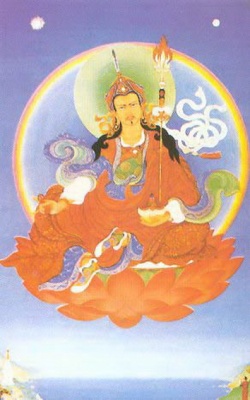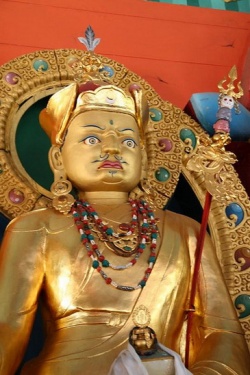Padmasambhava in Tibetan Mythology
As time passed, Padmasambhava's legend grew. The full account of Padmasambhava's iconic and mythological role in Tibetan Buddhism would fill volumes, and there are stories and legends about him beyond counting. Here is a very abridged version of Padmasambhava's mythic story.
Padmasambhava -- whose name means "born of the lotus" -- was born a the age of eight from a flowering lotus in Dhanakosha lake in Uddiyana. He was adopted by the king of Uddiyana. In adulthood he was driven from Uddiyana by evil spirits.
Eventually he came to Bodh Gaya, the place where the historical Buddha realized enlightenment, and was was ordained a monk. He studied at the great Buddhist university at Nalanda in India, and he was mentored by many significant teachers and spiritual guides.
He went to the Cima Valley and became the disciple of a great yogi named Sri Simha, and received tantric empowerments and teachings. Then he went to the Kathmandu Valley of Nepal, where he lived in a cave with the first of his consorts, Mandarava (also called Sukhavati). While there, the couple received texts on Vajrakilaya, an important tantric practice. Through Vajrakilaya, Padmasambhava and Mandarava realized great enlightenment.
Padmasambhava became a renowned teacher, and on many occasions he performed miracles that brought demons under control. This ability eventually took him to Tibet, to cleanse the site of the Emperor's monastery from demons. The demons -- the gods of indigenous Tibetan religion -- were converted to Buddhism and became dharmapalas, or protectors of the dharma.
Once the demons were pacified, the building of Tibet's first monastery could be completed. The first monks of this monastery, Samye, were the first monks of Nyingmapa Buddhism.
Padmasambhava returned to Nepal, but seven years later he came back to Tibet. The Emperor Trisong Detsen was so overjoyed to see Padmasambhava he offered Padmasambhava all the wealth of Tibet. The tantric master refused these gifts. But he did accept a lady from the Emperor's harem, the princess Yeshe Tsogyal, as his second consort, provided the princess accept the relationship of her free will.
Together with Yeshe Tsogyal, Padmasambhava hid a number of mystic texts (terma) in Tibet and elsewhere. Terma are found when disciples are ready to understand them. One terma is the Bardo Thodol, known in English as the "Tibetan Book of the Dead." Yeshe Tsogyal became Padmasambhava's dharma heir, and she transmitted the Dzogchen teachings to her disciples. Padmasambhava had three other consorts, and the five women are called the Five Wisdom Dakinis.
The year after Tri-song Detsan died, Padmasambhava left Tibet for the last time. He dwells in spirit in a pure Buddha-field, Akanishta.
In Tibetan art, Padmasambhava is depicted in eight aspects:
Pema Gyalpo (Padmaraja) of Uddiyana, the Lotus Prince. He is depicted as a young prince..
Lo-den Chokse (Sthiramati) of Kashmir, the Intelligent Youth, beats a drum and holds a skull bowl.
Sakya-seng-ge (Bhikshu Sakyasimha) of Bodh Gaya, Lion of the Sakyas, is portrayed as an ordained monk.
Nyima O-zer (Suryabhasa) of Cina, the Sunray Yogi, wears only a loincloth and holds a trident pointing to the sun.
Seng-ge Dra-dok (Vadisimha) of Nalanda University, the Lion of Debate. He is usually dark blue and holds a dorje in one hand and a scopion in the other.
Pema Jung-ne (Padmasambhava) of Zahor, the Lotus-born, wears monks' robes and holds a skull bowl.
Pemakara of Tibet, Lotus-creator, sits on a lotus, wearing Tibetan monk's robes and Tibetan boots. He holds a vajra in his right hand and a skull bowl in his left. He has a trident staff and a Nepalese cloth crown.
Dorje Dro-lo of Bhutan is a wrathful manifestation known as "Diamond Guts."

